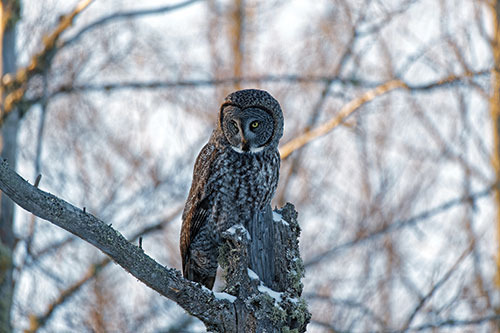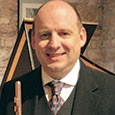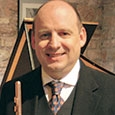I remember my teacher, the late great Bernard Z. Goldberg, telling me how he first fell in love with his chosen instrument. He was sitting in a movie theater, hearing the beautiful orchestral flute float about the auditorium, and he was, in his own word, “hooked.” He knew from that moment on that was his art form.
Goldberg was a wonderful teacher and an incredible flutist and conductor. He not only helped to improve my listening ability, but he taught me to listen with the creative part of my brain and to use my imagination and always play from the heart, which meant that I had to listen from my heart.
Many fellow flutists have similar stories about how they got started. Something about the magical sound of the flute spoke to them, and they all knew that it was to be a lifelong love. My story is similar. I was not the best beginner, but I did listen. Unfortunately, the first sounds I heard sounded more like cats scratching on the window according to my older brothers. One day, however, something happened, and my sound turned into tone, and I knew the difference. Then tone turned into something more like color, and I knew that I was on the right track. My ears told me what to do, and I did my best to achieve that color.
I was raised in a home filled with the arts, dancing, theater, and singing. My mother was wonderful at fostering this atmosphere. One day she saw I was really getting into my flute playing and decided to surprise me with my first LP, Jean Pierre Rampal playing Baroque concerti, Devienne, Naudot and Loeilliet. I have since owned two LPs and a CD of this as I literally played it day after day. It is almost impossible to put in words the beauty of his performance – that incredible tone and artistry. I do my best to play it even though I cannot explain what he did.
Listening to Rampal and other artists planted a seed in my brain, I do not really know how I attempted to mimic that incredible array of colors coming out of his flute, but as I listened something inside that mechanism guided me to the correct focus to at least start to achieve the result I wanted.
My experience was further enriched by my first teacher who was not a very good flute player but was a great musician and talented composer. Before quickly sending me on to a proper flute teacher, he taught me that music is not just sound. It is stories told with sound. Nature was music as much as anything. His concept of tone was rooted in the birds and wildlife that were so abundant in our small town in Minnesota. Years later, not long before he passed away, he wrote a flute solo piece for me featuring bird sounds. When playing through it, I realize how lucky I was to benefit from his influence.
Musicians are often taught that to listen to themselves and to the other musicians they are playing with. However, nature is listening to us as much as we listen to nature. This became apparent to me early on as I practiced in an enclose porch when the weather was good. The more often I played there, the more the birds in the area gathered around the porch and seemed to be having a conversation with me.
Mr. Goldberg also believed in the value of practicing in nature or looking out the window while playing. In a masterclass when asked what to do if there were no windows in the room, he simply said to practice staring into a painting. When another student asked him what to do when no painting was in the room, he said to close your eyes and imagine any place you like.
Once I learned to practice properly I began my valued friendship with Monsieurs Taffanel and Gaubert. I learned to listen to the scales as I played as well as the thirds, arpeggios, and chromatic scales. Listening is different from just hearing. Listening requires imagination and creativity. One teacher taught me to find the joy of scales by pretending I was riding my bike or sliding down a slide or skiing. Chromatic scales were like insects buzzing around me, much like Flight of the Bumble Bee. Listening in this manner teaches musicians to interpret everything they play, even long tones, octaves and harmonics. I encourage my students to listen to the higher note of an octave slur as they look out the window, listening to it trail off in the distance so that someone will hear it as it drifts their way. How others listen to us is important too. When practicing one can blast to get people’s attention, but it is better to draw them in with beautiful playing. Focus on creating a soft and intense purity of tone.
Flutists will grow and evolve into better artists if they listen to aspects of their playing such as dynamics and articulation. Are dynamics merely soft and loud, or do they have shades of color, much like are seen when a prism is held up to the light? I find that is an excellent visual concept to adopt. I remember hearing an owl outside my bedroom window as a kid very early each morning. It was like a gentle alarm clock, intense yet far off. Years later that is what a beautiful pianissimo is to me. I use that image of the owl in my ears so that my pianissimo is not airy, weak or low in pitch.

I never understood articulations well until I applied these same principles to them. I feel a slur rather than just simply playing a slur. I have to listen for how I want it to sound, what shape I want, and so forth. If I listen to the slur, it starts to make more sense as it often outlines and emphasizes the melody, especially in Baroque and Classical music. I often have students listen to how string players begin a phrase or play slurs. The bow movement is a visible way to observe how they are shaping individual notes and phrases.
A student recently asked me about the term staccato. She had been told it meant short. I explained that it really depends on the style of the music being played. Perhaps the answer lies in imitating a dry pizzicato on the violin, the way a pianist bounces or jumps on the keys, or a beautiful ringing tone from a trumpet. To create any of these effects, she would have to listen to the other musicians around her to get the desired effect. She could also look to nature for inspiration, such as the round, gentle staccato heard when rain falls on a roof.
Great singers in both the opera and theater worlds have been some of my other great influences. Listening to opera singers helped me realize that the breath is not an interruption between two notes but a bridge that holds all of the phrases together. I do not always trying to hide the breath after hearing Broadway singers who seem to breathe in a sighing fashion that is made more dramatic by the sound of the breath. Listening to other wind and string players and singers broadens flutists’ understanding and concept of breathing and articulation.
When I was playing and teaching in Asia earlier this year, I was asked by a number of students how I started flute and why music is such a big part of my life. After pondering for a few minutes, I gave the simplest answer I could. Music is a language and a gift we have been given that connects the spiritual world with our physical reality. So, listen with your ears, but always play from your heart.






